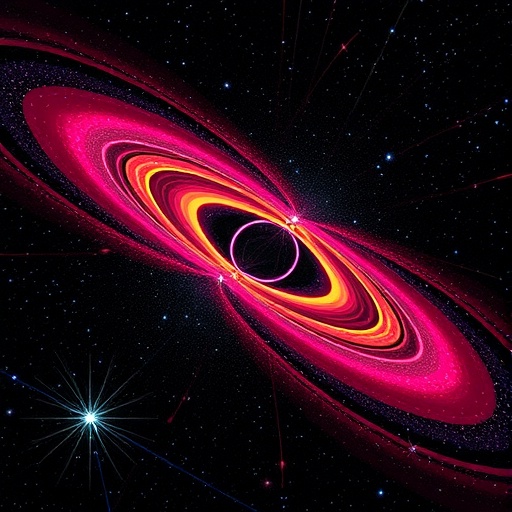In a groundbreaking advancement for the field of gravitational-wave astronomy, physicists at the University of California, Riverside, have introduced an innovative technology designed to revolutionize the sensitivity and precision of gravitational-wave detectors. This novel system, named FROSTI—short for FROnt Surface Type Irradiator—promises to enhance the Laser Interferometer Gravitational-Wave Observatory (LIGO) capabilities by mitigating the distortions caused by intense laser power, potentially opening a new vista into the farthest reaches of the cosmos.
Gravitational waves, faint ripples in the fabric of spacetime predicted by Einstein’s Theory of Relativity, were first directly observed by LIGO in 2015. This monumental discovery not only confirmed decades-old theoretical predictions but also inaugurated an entirely new method of astronomical observation that captures cataclysmic events such as black hole and neutron star mergers. LIGO achieves this through the use of two massive laser interferometers stretching four kilometers each, capable of detecting minute alterations in distance smaller than one-thousandth the diameter of a proton. Such extraordinary precision demands unprecedented stability and clarity in the optical components, especially the main mirrors.
The primary mirrors in LIGO stand as engineering marvels, each crafted to exacting specifications to ensure their surfaces remain perfectly shaped under extreme conditions. Weighing approximately 40 kilograms with a diameter of 34 centimeters, these mirrors reflect the intense laser beams that must maintain coherence over vast distances. However, escalating the laser power to boost detector sensitivity poses a formidable challenge: the heat generated by these lasers subtly warps the mirror surfaces, introducing distortions that can mask or mimic gravitational-wave signals.
FROSTI tackles this obstacle by implementing an advanced adaptive optics mechanism that actively counteracts thermal deformations on the mirror surfaces. Unlike previous approaches that relied on coarse and limited correction methods, FROSTI employs a sophisticated thermal projection system capable of delivering highly localized and fine-tuned heating patterns. This technique exploits precision-controlled radiation to adjust the mirror wavefronts meticulously, thereby restoring their ideal shapes even under laser powers exceeding one megawatt—around five times the power currently utilized by LIGO, and over a billion-fold more intense than a standard laser pointer.
Remarkably, although its name suggests coldness, FROSTI operates by applying heat strategically rather than cooling. By projecting calibrated thermal gradients onto the mirror’s front surface, it alleviates distortions caused by laser-induced heating deeper within the mirror substrate. Crucially, this method avoids introducing additional noise, which is pivotal since any extraneous vibrations or fluctuations can easily swamp the faint signals researchers endeavor to measure.
The implications of this technology extend far beyond the current operational thresholds of LIGO. To unlock the next frontier in gravitational-wave astrophysics, future detectors must simultaneously increase laser power and maintain quantum-level measurement precision. This is a delicate balance because higher laser intensities tend to degrade the quantum states integral to signal clarity. FROSTI’s precise wavefront corrections offer a path forward, enabling enhancements in laser power without sacrificing the quantum noise advantages that are crucial to detecting distant and subtle cosmic phenomena.
Demonstrated through rigorous experimental validation, FROSTI’s prototype was tested using one of LIGO’s standard 40-kilogram mirrors. The success of these trials affirms the system’s robustness, scalability, and potential for integration into forthcoming upgrades such as LIGO A#—a planned enhancement designed as a precursor to even larger observatories. Among these future installations, the Cosmic Explorer project envisions mirrors weighing approximately 440 kilograms, demanding proportionally more sophisticated adaptive optics solutions akin to FROSTI’s design principles.
Beyond its immediate technical triumphs, FROSTI represents a significant stride towards extending the reach and acuity of gravitational-wave astronomy. With its help, scientists anticipate an order-of-magnitude increase in detection volume, vastly broadening our observational horizon to encompass millions of black hole and neutron star mergers scattered across the universe. This expanded catalog will not only deepen our understanding of these enigmatic objects but also shed light on fundamental questions in cosmology, nuclear physics, and the behavior of matter under extreme conditions.
Jonathan Richardson, an assistant professor of physics and astronomy at UCR and the lead scientist behind FROSTI, emphasizes this innovation as a gateway to the next 20 years of discovery. “By enabling adaptive control of mirror wavefronts at megawatt power scales, we’ve laid the groundwork for instruments that can peer further and with greater fidelity than ever before,” he notes. His team, collaborating with researchers from MIT and Caltech, continues to refine the technology, aiming to tackle even more complex optical aberrations that future detectors will inevitably encounter.
Importantly, FROSTI’s development was supported by a National Science Foundation grant, reflecting the broader scientific community’s recognition of its potential impact. The team’s seminal paper, titled “Demonstration of a next-generation wavefront actuator for gravitational-wave detection,” published in the journal Optica, provides comprehensive details about the design, experimental methodology, and performance metrics of this pioneering actuator.
As gravitational-wave observatories push the envelope of precision measurement, innovations like FROSTI embody the intricate blend of physics, engineering, and technology that powers scientific breakthroughs. They not only address immediate technical hurdles but also inspire a vision where humanity’s grasp of the cosmos grows ever deeper, reshaping our understanding of the universe’s most powerful and mysterious events.
Subject of Research: Not applicable
Article Title: Demonstration of a next-generation wavefront actuator for gravitational-wave detection
News Publication Date: 26-Sep-2025
Web References: https://opg.optica.org/optica/fulltext.cfm?uri=optica-12-10-1569&id=581696
References: DOI: 10.1364/OPTICA.567608
Image Credits: Not provided
Keywords
Gravitational waves, LIGO, adaptive optics, FROSTI, Laser Interferometer, wavefront control, Cosmic Explorer, quantum noise, laser interferometers, mirror distortion correction, thermal projection system, astrophysics technology




